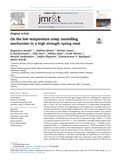Citation link:
http://dx.doi.org/10.25819/ubsi/10281| DC Field | Value | Language |
|---|---|---|
| crisitem.author.orcid | 0000-0002-0465-3696 | - |
| crisitem.author.orcid | 0000-0002-6182-3444 | - |
| crisitem.author.orcid | 0000-0002-3974-8847 | - |
| crisitem.author.orcid | 0000-0002-9292-5064 | - |
| crisitem.author.orcid | 0000-0002-2263-6363 | - |
| dc.contributor.author | Remalli, Nagarjuna | - |
| dc.contributor.author | Münch, Mathias | - |
| dc.contributor.author | Hasan, Mohsin | - |
| dc.contributor.author | Kishore, K Nanda | - |
| dc.contributor.author | Stern, Felix | - |
| dc.contributor.author | Baak, Nikolas | - |
| dc.contributor.author | Walther, Frank | - |
| dc.contributor.author | Sambandam, Manjini | - |
| dc.contributor.author | Klapprott, Steffen | - |
| dc.contributor.author | Rajulapati, Koteswararao V | - |
| dc.contributor.author | Brandt, Robert | - |
| dc.date.accessioned | 2023-02-22T10:09:25Z | - |
| dc.date.available | 2023-02-22T10:09:25Z | - |
| dc.date.issued | 2022 | de |
| dc.description | Finanziert aus dem Open-Access-Publikationsfonds der Universität Siegen für Zeitschriftenartikel | de |
| dc.description.abstract | Despite of the well-known fact that high strength steels are exhibiting low temperature creep deformation, its rate controlling mechanism is yet to be understood. The strain hardening theory and the exhaustion creep model were proposed almost seven decades ago to unravel the low temperature creep mechanism in a single phase homogeneous isotropic material. However, their applicability to low temperature creep deformation in a technical material like a modern high strength steel is still a matter of investigation owing to their nature of multi-phase, in-homogeneous, and an-isotropic behavior. The authors have grabbed this chance to experimentally validate the exhaustion creep model based on low temperature creep tests of the SAE 9254 spring steel. | en |
| dc.identifier.doi | http://dx.doi.org/10.25819/ubsi/10281 | - |
| dc.identifier.uri | https://dspace.ub.uni-siegen.de/handle/ubsi/2474 | - |
| dc.identifier.urn | urn:nbn:de:hbz:467-24748 | - |
| dc.language.iso | en | de |
| dc.rights | Attribution-NonCommercial-NoDerivatives 4.0 International | * |
| dc.rights.uri | http://creativecommons.org/licenses/by-nc-nd/4.0/ | * |
| dc.source | Journal of Materials Research and Technology ; 21, S. 2309–2315. - https://doi.org/10.1016/j.jmrt.2022.09.131 | de |
| dc.subject.ddc | 620 Ingenieurwissenschaften und zugeordnete Tätigkeiten | de |
| dc.subject.other | Martensitic steel | en |
| dc.subject.other | Low temperature creep | en |
| dc.subject.other | Exhaustion creep model | en |
| dc.subject.other | Dislocation glide | en |
| dc.subject.other | Slip localization | en |
| dc.subject.other | Strain induced phase transformation | en |
| dc.subject.other | Martensitischer Stahl | de |
| dc.subject.other | Kriechen bei niedriger Temperatur | de |
| dc.subject.other | Modell des Erschöpfungskriechens | de |
| dc.subject.other | Versetzungsgleiten | de |
| dc.subject.other | Lokalisierung von Schlupf | de |
| dc.subject.other | Dehnungsinduzierte Phasenumwandlung | de |
| dc.subject.swb | Martensitischer Stahl | de |
| dc.subject.swb | Kriechverhalten | de |
| dc.title | On the low temperature creep controlling mechanism in a high strength spring steel | en |
| dc.type | Article | de |
| item.fulltext | With Fulltext | - |
| ubsi.publication.affiliation | Department Maschinenbau | de |
| ubsi.source.doi | 10.1016/j.jmrt.2022.09.131 | - |
| ubsi.source.issn | 2214-0697 | - |
| ubsi.source.issued | 2022 | de |
| ubsi.source.issuenumber | 21 | de |
| ubsi.source.pagefrom | 2309 | de |
| ubsi.source.pageto | 2315 | de |
| ubsi.source.place | Rio de Janeiro | de |
| ubsi.source.publisher | Elsevier | de |
| ubsi.source.title | Journal of materials research and technology | de |
| ubsi.subject.ghbs | ZLQ | de |
| Appears in Collections: | Geförderte Open-Access-Publikationen | |
Files in This Item:
| File | Description | Size | Format | |
|---|---|---|---|---|
| On_the_low_temperature_creep_controlling_mechanism.pdf | 1.51 MB | Adobe PDF |  View/Open |
This item is protected by original copyright |
Page view(s)
264
checked on Nov 28, 2024
Download(s)
94
checked on Nov 28, 2024
Google ScholarTM
Check
Altmetric
This item is licensed under a Creative Commons License


